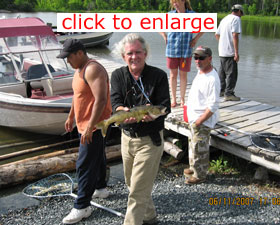|
|||
Rare opportunity in Rare EarthsBob Moriarty I love trips where I learn something. Which is most of them but the more I learn, the more I enjoy the trip. I recently visited my first REE (Rare Earth Elements) project in Canada. It's located right on a great fishing lake. Which makes it even better.  There are 15 elements termed Rare Earths, and the elements yttrium and scandium. I can't even pronounce the names of many of them. They aren't particularly rare. The most abundant is cerium and it is the 25th most abundant element in the earth's crust. Even the least common REE, lutetium, is 200 times more common than gold. But as with most minerals, it's not the rarity that counts. To mine any mineral it must be concentrated economically. Even the water in the sea contains vast amounts of gold, six kilos per cubic kilometer. But the energy required to process the water would far outweigh the value of the gold. REE are common but concentrations of REE are rare. My first question about Rare Earth Elements had to do with just what they are used for. I'm going to quote this from here, "Their compounds are used as catalysts in the production of petroleum and synthetic products. Lanthanides are used in lamps, lasers, magnets, phosphors, motion picture projectors, and X-ray intensifying screens. A pyrophoric mixed rare-earth alloy called Mischmetall (50% Ce, 25% La, 25% other light lanthanides) or misch metal is combined with iron to make flints for cigarette lighters. The addition of 1% Mischmetall or lanthanide silicides improves the strength and workability of low alloy steels. Remember that, we are going to have a test tomorrow. But all kidding aside, every day brings more uses for the REE. One shocker for me was the amount of REE in the new hybrid cars. In an average automobile, we use 9 pounds of zinc to give you a reference point. In the hybrid cars, we use an incredible 45 pounds of Rare Earth Elements. Even without the rapidly-increasing demand for REE in hybrids, we use them almost anywhere scientists create new materials which are smaller, lighter, stronger or faster. We use REE in new battery technology, fuel cells, smaller and faster memory chips, thin film solar energy panels, even for the color phosphors in flat screen TV monitors. I went to Canada two weeks ago and spent a day being briefed about REE by the management team at Avalon Ventures Ltd. (AVL-V) I learned a lot about REE but that was fairly easy since I had no clue about them before sitting down. Avalon is positioned to be the Canadian experts in REE and there is more to that than just mining and making a profit. Right now, 95% of all REE are produced in China. From a strategic point of view, that's very dangerous for any country manufacturing products using REE since China is in a position to cut supplies for any reason. Canada needs a safe and dependable supply of REE. Avalon would be in the Cat Bird's seat should there be any interruption of supply from China. To add to the confusion, there are two types of REE mines, those predominant in the light REE and those predominant in the heavy (and more valuable) REE. Avalon has a total of five REE projects and the most advanced project; Thor Lake is a massive heavy REE deposit. There aren't a lot of comparables I can give a reader which would lead them to an easy understanding of mining and milling REE. It's complicated, not even the internet sites agree on just how many elements make up the REE. But Avalon just released a scoping study on Thor Lake that makes everything very simple. You don't need to understand REE to invest in AVL. As the scoping study points out, at today's prices, mining 2,000 tons a year of REE would generate a 26.7% ROI (Return on Investment) and mine life of 18 years. The NPV (Net Present Value) would be a whopping $356 million dollars. They are worth about $100 million today. I will give Avalon tops marks for their website. The entire area of REE is not well known and the site gives a lot of valuable information. Rather than try to teach potential investors everything they need to know about the mining and uses of REE, I'd suggest going to their website, it's excellent. If you can add and subtract, basically you know everything you need to know about the company. I will admit I was having a hard time putting a value on the company, mining in the NWT is very expensive and I'm not familiar with the value of REE minerals. But a NPV on one project of $356 million is a hell of a lot higher than today's market cap. I can't see how an investor could go wrong at these prices. The stock is hitting new yearly highs but it's going higher. Avalon is not an advertiser and we don't own shares but I wish I had written this two weeks ago when the scoping study came out. This is a fairly risk free investment at the $2-$2.50 level. I like the company and I like the management and there are a bunch of other REE projects. I think this is a production story and then the stock will really roar. Avalon Ventures Ltd Bob Moriarty |
